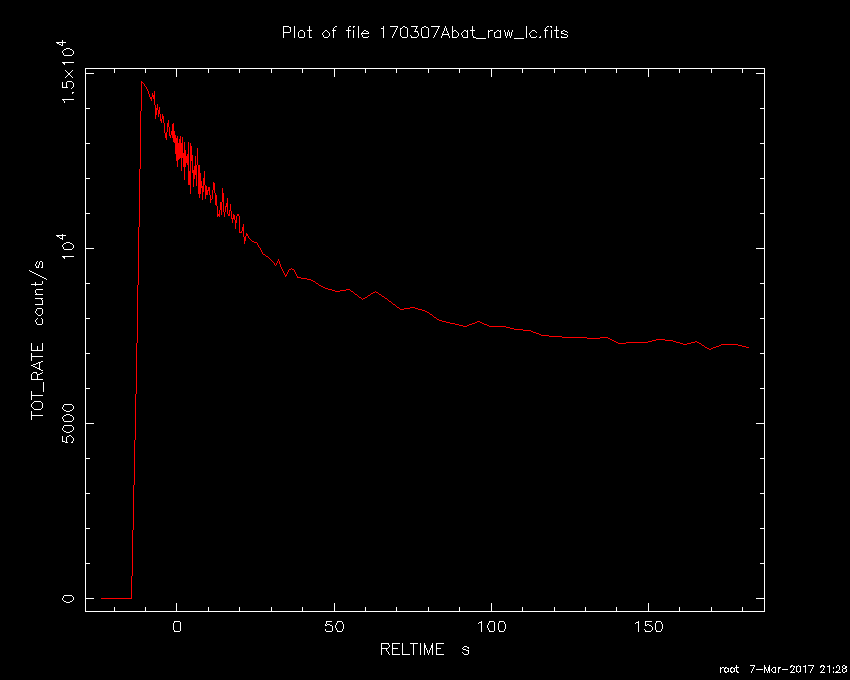(All information courtesy of the instrument teams.)
![]() Previous IAU Circulars
Previous IAU Circulars
TITLE: GCN/SWIFT NOTICE
NOTICE_DATE: Tue 07 Mar 17 20:25:48 UT
NOTICE_TYPE: Swift-BAT GRB Position
TRIGGER_NUM: 741528, Seg_Num: 0
GRB_RA: 13.535d {+00h 54m 08s} (J2000),
13.759d {+00h 55m 02s} (current),
12.884d {+00h 51m 32s} (1950)
GRB_DEC: +9.537d {+09d 32' 11"} (J2000),
+9.629d {+09d 37' 46"} (current),
+9.265d {+09d 15' 56"} (1950)
GRB_ERROR: 3.00 [arcmin radius, statistical only]
GRB_INTEN: 0 [cnts] Image_Peak=1699 [image_cnts]
TRIGGER_DUR: 72.000 [sec]
TRIGGER_INDEX: 20000 E_range: 15-50 keV
BKG_INTEN: 0 [cnts]
BKG_TIME: 0.00 SOD {00:00:00.00} UT
BKG_DUR: 0 [sec]
GRB_DATE: 17819 TJD; 66 DOY; 17/03/07
GRB_TIME: 73461.28 SOD {20:24:21.28} UT
GRB_PHI: -55.69 [deg]
GRB_THETA: 33.26 [deg]
SOLN_STATUS: 0x13
RATE_SIGNIF: 0.00 [sigma]
IMAGE_SIGNIF: 7.12 [sigma]
MERIT_PARAMS: +1 +0 +0 +6 +1 -3 -100 +0 -87 +0
SUN_POSTN: 348.46d {+23h 13m 51s} -4.95d {-04d 57' 15"}
SUN_DIST: 29.12 [deg] Sun_angle= -1.7 [hr] (East of Sun)
MOON_POSTN: 109.31d {+07h 17m 14s} +18.51d {+18d 30' 21"}
MOON_DIST: 92.14 [deg]
MOON_ILLUM: 76 [%]
GAL_COORDS: 124.05,-53.33 [deg] galactic lon,lat of the burst (or transient)
ECL_COORDS: 16.15, 3.45 [deg] ecliptic lon,lat of the burst (or transient)
COMMENTS: SWIFT-BAT GRB Coordinates.
COMMENTS: This is an image trigger. (The RATE_SIGNIF & BKG_{INTEN, TIME, DUR} are undefined.)
COMMENTS: A point_source was found.
COMMENTS: This does not match any source in the on-board catalog.
COMMENTS: This does not match any source in the ground catalog.
COMMENTS: This is a GRB.
COMMENTS: This trigger occurred at longitude,latitude = 343.83,-9.62 [deg].

TITLE: GCN/SWIFT NOTICE
NOTICE_DATE: Tue 07 Mar 17 20:28:30 UT
NOTICE_TYPE: Swift-BAT GRB Lightcurve
TRIGGER_NUM: 741528, Seg_Num: 0
GRB_RA: 13.535d {+00h 54m 08s} (J2000),
13.759d {+00h 55m 02s} (current),
12.884d {+00h 51m 32s} (1950)
GRB_DEC: +9.537d {+09d 32' 11"} (J2000),
+9.629d {+09d 37' 46"} (current),
+9.265d {+09d 15' 56"} (1950)
GRB_DATE: 17819 TJD; 66 DOY; 17/03/07
GRB_TIME: 73461.28 SOD {20:24:21.28} UT
TRIGGER_INDEX: 20000
GRB_PHI: -55.69 [deg]
GRB_THETA: 33.26 [deg]
DELTA_TIME: 0.00 [sec]
TRIGGER_DUR: 72.000 [sec]
SOLN_STATUS: 0x13
RATE_SIGNIF: 0.00 [sigma]
IMAGE_SIGNIF: 7.12 [sigma]
LC_URL: sw00741528000msb.lc
SUN_POSTN: 348.47d {+23h 13m 52s} -4.95d {-04d 57' 12"}
SUN_DIST: 29.12 [deg] Sun_angle= -1.7 [hr] (East of Sun)
MOON_POSTN: 109.34d {+07h 17m 20s} +18.50d {+18d 30' 15"}
MOON_DIST: 92.16 [deg]
MOON_ILLUM: 76 [%]
GAL_COORDS: 124.05,-53.33 [deg] galactic lon,lat of the burst (or transient)
ECL_COORDS: 16.15, 3.45 [deg] ecliptic lon,lat of the burst (or transient)
COMMENTS: SWIFT-BAT GRB Lightcurve.
COMMENTS:
COMMENTS: The next comments were copied from the BAT_POS Notice:
COMMENTS: This is an image trigger.
COMMENTS: A point_source was found.
COMMENTS: This does not match any source in the on-board catalog.
COMMENTS: This does not match any source in the ground catalog.
COMMENTS: This is a GRB.
COMMENTS: This trigger occurred at longitude,latitude = 343.83,-9.62 [deg].

RA(J2000) = 00h 54m 08s Dec(J2000) = +09d 32' 11"with an uncertainty of 3 arcmin (radius, 90% containment, including systematic uncertainty). The BAT light curve shows that Swift was emerging from the SAA at this time, giving a quickly-decreasing count rate that would swamp any variation expected from the source at the nominal intensity implied by the image strength.
RA(J2000) = 00h 54m 02.5s Dec(J2000) = +09d 32' 17.9"with an uncertainty of 2.5 arcmin, (radius, sys+stat, 90% containment). The partial coding was 43%.